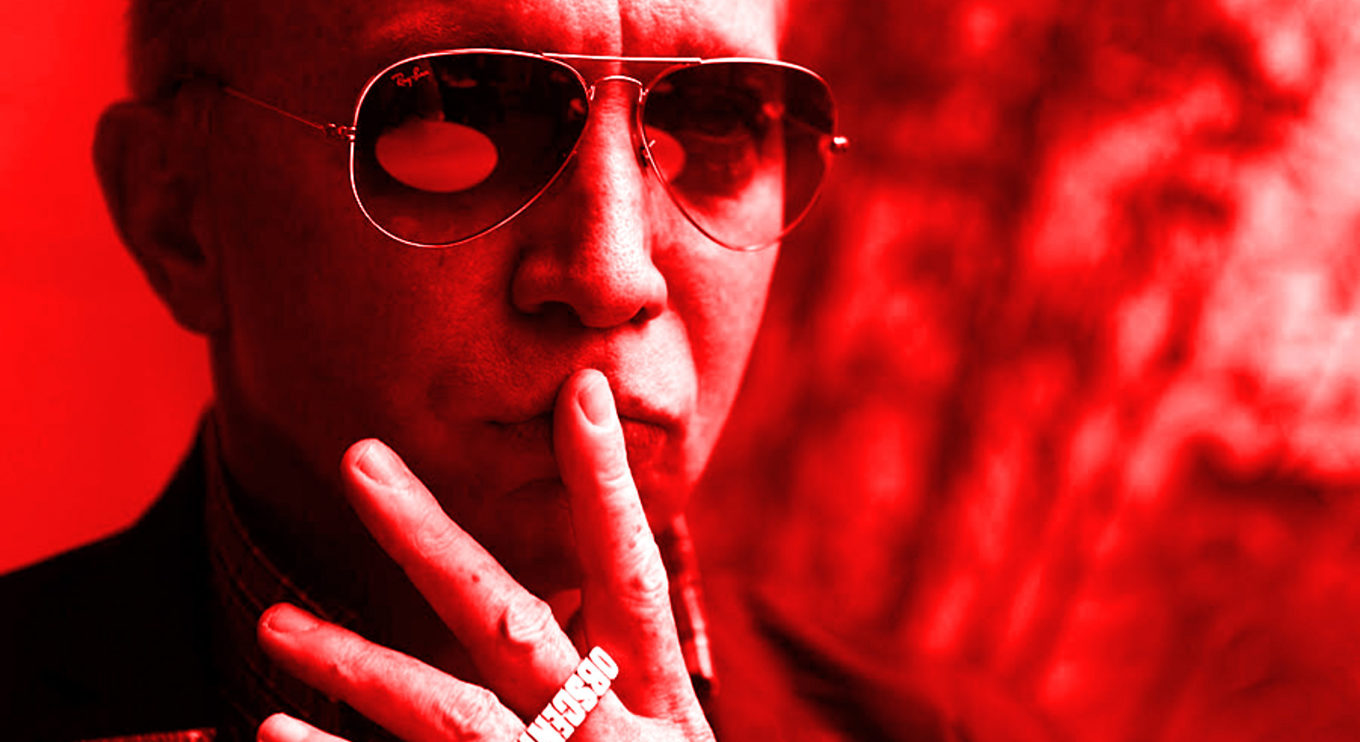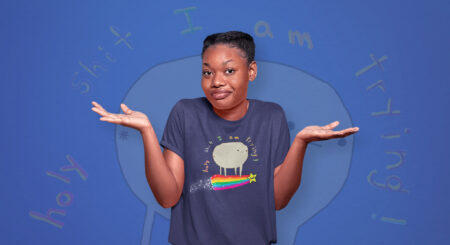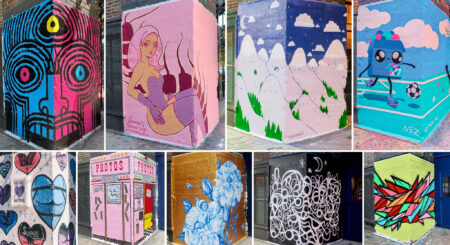CAUTION: This interview with Canadian filmmaker Bruce LaBruce includes potentially NSFW images depicting gore and violence. His Threadless Artist Shop also contains similar images and more sexually explicit art.
Bruce LaBruce is no stranger to rocking the boat. Over the last 30 years, he’s been making controversial films that push the boundaries of queer culture. Since his first film, No Skin Off My Ass, debuted in 1991, the Toronto artist and filmmaker has written and directed 11 films. His notable works range from the gay horror-porn extravaganza L.A. Zombie to the romantic comedy-drama Gerontophilia, which won the Grand Prix at Montreal’s Festival du Nouveau Cinema in 2013. And let’s not forget his Berlin–based cult classic The Raspberry Reich, with its iconic tagline: “The Revolution is My Boyfriend.”
LaBruce has left a lasting impression on the film industry. Retrospectives of his career have been seen everywhere from the Museum of Modern Art and the Toronto International Film Festival. He also recently earned the Tom of Finland Foundation Award 2020 for his commitment to art and culture. Instead of resting on his laurels, he continues to add to his film catalog with his latest feature, Saint-Narcisse. It’s currently on the festival circuit and will be released internationally in 2021.

Aside from film, LaBruce has also created a jewelry collection with Jonathan Johnson, and is a prolific photographer. His recently released Death Book delivers a 15-year collection of photos themed around death, blood, gore, and horror. It also features candid shots of actors Asia Argento and Udo Kier. In the spring, he plans to release a new book of photos called Fixations, which is a 30-year retrospective of his visual work, including photos of actress Rossy de Palma and a foreword by film director Gus Van Sant.
This week, LaBruce launched his new Threadless shop, which boasts more than 50 designs inspired by his famous works. Some of his most iconic images appear on everything from t-shirts and sweatshirts to phone cases and shower curtains. Shedding light on his career, he speaks from his home in Toronto about irony, West Hollywood, and being the ultimate sexual radical.
How did you decide on what to create for your Threadless shop?
Bruce LaBruce: I’ve found Threadless to be quite collaborative. So, basically I went through my archive of photos, frames, and posters from my movies and sent Lance [Artist Shops Account Director] quite a lot of material to work from, and he came back with really great ideas about which images would work best and on which products. Then I did some editing, additions and subtractions, and voila! I’ve done The Raspberry Reich slogans as t-shirts before, notably in collaboration with the late, great Will Munro. But that was a long time ago, so I thought it was time to revisit those. And I love the use of the various movie posters of mine too!
How has the slogan “The Revolution is My Boyfriend” from your 2004 film, The Raspberry Reich, changed meaning over time?
That’s a great question because it really underscores how much the world has changed in only 15 years. My movie The Raspberry Reich was in one way a response to the aftermath of 9/11—the bombing on the World Trade Center in NYC. After that event, when I would visit Manhattan (I went to the site of Ground Zero in December of 2001), I was a bit shocked at how blatantly conservative the zeitgeist had become almost overnight.
When I would go to downtown bars, I learned that I had to be careful about what I said about the USA and its foreign policy, or say, about defending Muslims. My boyfriend at the time was a devout Shia Muslim, so maybe I was over-sensitized, but still! Previously casual leftist acquaintances of mine, and even some good friends, started to express more conservative views. I think that’s what laid the groundwork for the extreme shift to the right in the USA that has recently emerged.

Wow.
So, with The Raspberry Reich, I wanted to make a movie that espoused extreme leftist viewpoints and slogans, partly as a provocation, and partly to draw attention to this new conservatism. But what some people didn’t quite understand is that I was also simultaneously offering a critique of the radical left, which I had more than a passing acquaintance with as a punk and cultural anarchist, and the phenomenon of “radical chic”—the way in which corporate pop culture and fashion have had a tendency to use emptied-out signifiers of political radicalism to move the merch. Then I got sued by the estate of Korda, the photographer who took the famous image of Che Guevera which I used quite pointedly in my movie, but that’s another story (check my website for the whole sordid story).
That’s a lot.
The Raspberry Reich slogans, including “The Revolution is My Boyfriend,” were always intended somewhat ironically, although my irony is always infused with a large dose of sincerity. Supporting and holding certain radical ideals and simultaneously affectionately critiquing the people who espouse them but who don’t practice what they preach, or who start to betray their original beliefs either by becoming too extreme or not extreme enough—the phenomenon of the oppressed becoming the oppressor—is kind of my specialty!
So today, as leftist radicalism has become somewhat more mainstream, and conservative radicalism has gone completely off the rails into LaLa Land, I think the slogans now take on a more literal, sincere tone. I mean, I’m still moving merch with them, but then again, I’m not a corporate entity. It’s pretty much DIY, and as Threadless is a completely sustainable company and makes sure there is no exploitation in the manufacturing of their products, I think the irony and the sincerity can nicely co-exist.

Why do you love working with author Slava Mogutin?
I met Slava soon after he was literally exiled by the Russian government in the nineties for “exceptional cynicism,” “malicious hooliganism,” and “extreme insolence.” I’m not making that up! As a journalist, he was outing gay politicians and he staged his own gay marriage for the media. I knew then that we were destined to be besties. He interviewed me in New York for a Russian-language book he was doing composed of interviews with famous homosexuals including Allan Ginsberg, William S. Burroughs, and Gus Van Sant, and we were great friends from that day on. He appeared in my movie Skin Flick, reciting his wonderful poetry, among other things! Several images of him from the movie are featured on Threadless merch. He also wrote the introduction for my new Death Book from Baron Books.
Looking back, another line from The Raspberry Reich is “Heterosexuality is the Opiate of the Masses.” How do you feel about it now?
Oh, I love that one. Of course, it’s a corruption of the slogan of the Godless Soviets: “Religion is the Opiate of the Masses.” I think the sentiment is even more relevant today as the world seems to be becoming more and more regressive, witnessed by anti-gay protests and laws. It’s more important than ever to be radical and in-your-face about homosexuality. I’m not talking about homo-nationalism—I abhor nationalism of any stripe—but just being a thorn in the creamy underbelly of the heterosexual mainstream, as I have been called, is always a good look. And by the way, it’s also good to be a thorn in the creamy underbelly of the gay assimilation movement as well, a tendency that encourages queers to be monogamous, well-behaved, and as boring and inoffensive as possible. Quelle snore.

Looking back now, what was one of the best moments of shooting The Raspberry Reich?
Well, I don’t know if it was the best moment, but as I relay in my book The Porno Diaries, in the wee hours of the night before the first day of shooting, I stood on the chilly balcony of the friends I was staying with in Berlin on Karl-Marx Strasse and contemplated calling the whole movie off! We had such a miniscule budget, and the pre-production had not been going well at all, so I thought we should just call it a day! I called my producer to tell him, but he didn’t answer, so I went to bed and the next day we started shooting! I love that story! If he had answered I might have never made the movie!
Was it a prophecy in a way?
The Raspberry Reich also corresponded with the nascent emergence of radical queer movements in places in the world which had been previously grossly homophobic, and where violence against LGBTQI people was normal—places like Eastern Europe, South America, Cuba, Russia, Africa, etc. So, my movie did become somewhat of a cult hit and played at over 150 film festivals worldwide. I toured with it for about a year and a half before we got slapped with the Che lawsuit.
So, in that sense, I think it tapped into a zeitgeist, and the movie became both a catalyst of queer empowerment and a prediction of queer political radicalism. It was also, of course, sexually explicit, because I believed you can’t make a movie about sexual radicalism without being sexually radical! But sadly, it may also have prophesized the co-option and dilution of that radicalism with the ascendance of assimilation and reform politics, and the stratification of the political spectrum, with Fascism on the right and Stalinism on the left.

In your “Fuck Off & Die” hoodie, who’s in the photo and where was it taken?
That’s a still I took on the set of Skin Flick featuring Slava Mogutin, who played Reinholt, and Nikki Uberti, who played his girlfriend, the illustrious Cameltoe. They were playing neo-Nazi skinheads. You had to be there. We were shooting a neo-Nazi skinhead porn movie, obviously a provocation against closeted fascists, including skinheads, whose movement is highly homoerotic and uses the strategy of sexual male-bonding to create solidarity and cohesion, but is simultaneously grossly homophobic.
We decorated a whole house in Brixton in London as a neo-Nazi skinhead headquarters. The denizens of Brixton, a hotbed of black leftist activism, were not happy that we were shooting in their neighborhood with actors styled as neo-Nazi skinheads wandering in and out of the building. But when we explained to them that it was a gay porn, they were mostly fine with it!
Your Hustler White tee brings us back to a side of Sunset Boulevard that’s long gone. What parts of West Hollywood do you love or loathe?
The dividing line for West Hollywood was always Fairfax Avenue. Anything west of Fairfax was for the bougie gays and sweater queens, the typical white middle-class gay ghetto. Exceptions were made for the legendary hustler bars Numbers and The Spotlight, which were both west of Fairfax, but were much more fun and hidden in more off-the-beaten-track locations. Anything east of Fairfax in West Hollywood was more on the grungier side, edgier, and more dangerous, especially the Santa Monica Boulevard strip where all the johns cruised the street prostitutes. That whole scene is gone now, a slice of L.A. history that we captured and preserved on celluloid in Hustler White just before its final demise.

What products are selling the best right now on Threadless?
Oh wait, let me check my dashboard. It looks like The Raspberry Reich, Hustler White, and No Skin Off My Ass (my first feature film) products are selling the best so far. But the most sales, about 30%, are “other designs,” so it’s pretty eclectic.
Why should we all look forward to watching your forthcoming film, Saint-Narcisse?
Oh, we also have Saint-Narcisse merch. Why? because it’s a great movie! It’s a movie about twincest (twin incest), which is very provocative, but also about narcissism, which these days everyone can relate to. In fact, at this point in history I would venture to say that “Narcissism is the Opiate of the Masses”!
The film premiered at the Venice Film Festival in early September, and because there was a COVID lull then, my producer and main actor and I were able to attend in person and premier it to a live audience. It all seems like a dream now! But the reception of the film was great, and it’s been playing on the festival circuit ever since, such that it is. My international sales agent has been selling it to various countries and territories. We just signed with a US distributor, which will be announced shortly. It will be widely available sometime in the middle of 2021.
Can you tell us more about your new book, Death Book, and who is in it?
My new book, Death Book, from Baron Books, is a compendium of my most violent, sexually violent, and extreme imagery since I started making movies in the late 1980s. But the imagery is largely over-the-top and camp—splatter, gore, and “gorn” intended to foreground the way that the corporate entertainment world uses extreme sex and violence to sell popcorn. There are a lot of previously unpublished photographs and Polaroids documenting the live events I have done for the past 20 years where I would stage bloody scenes of terrorist abduction and torture involving terrorists or revolutionaries or zombies or revolutionary zombies.

I would do live performances at the openings of my gallery shows or at special art events, and I would shoot models dressed as revolutionary characters splattering their victims with fake blood and gore. Then I’d invite the members of the public to participate, sometimes naked, as a cathartic experience. It undercuts the anxiety and trauma we may feel when we watch, for example, terrorist torture videos on the news and the Internet presented as titillating, sexy entertainment.
The atmosphere at these events is never negative, but has more a giddy feeling of liberation, catharsis, and playfulness. There are also photos from my zombie movies, like my gorn L.A. Zombie, which is about an alien zombie who goes around looking for dead bodies in L.A. to fuck back to life. Some of the people featured in Death Book include AA Bronson, Asia Argento, Lady Jaye Breyer, Vaginal Davis, Udo Kier, Kembra Pfahler, and Rick Owens. I have another photo book coming out next year called Fixations from Milos Mestas Publications. It’s a retrospective of a broader variety of my visual work over the past 30 years.
Are you afraid of death? Why or why not?
Yes and no. When I was a teenager, I had that epiphanous moment, that realization of the gaping truth that we are all going to die eventually. It really shook me at the time, but I think ultimately much of my work has been about working through that reality of death, acknowledging it, interpreting it, philosophizing about it, indulging in it, and finally, coming to terms with it. So, I’m fine with it at the moment. We’ll see what happens when its features become more definable.
What’s your favorite quote of all time?
I have two. The first is “The road to hell is paved with good intentions.” The second is “No good deed goes unpunished.” But I’m not cynical, I swear! In fact, I’m pretty much an optimist, against all odds!




